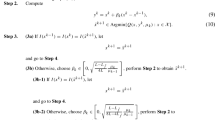Abstract
In this paper, we explore a method to parameterize a linear function with jump discontinuities, which we refer to as a “sawtooth” function, and then develop theory and algorithms for estimating the function parameters from noisy data in a least-squares framework. Because there will always exist a sawtooth function that exactly fits a given data set, one is led to bounding the maximum number of jumps the sawtooth function can have in order to obtain reasonable practical estimates. The main contribution of the paper is a proof that cardinality of the optimal solutions to a relaxation of the associated least-squares problem in which a constraint on the cardinality of the solutions is replaced by a 1-norm constraint on the vector of jumps is a monotonic function of the parameter of the relaxation. This property allows one to avoid dealing with the combinatorial cardinality constraint and quickly explore solutions using the proposed convex relaxation. A fitting algorithm based on the proposed results is developed and illustrated with a simple numerical example.




Similar content being viewed by others
Notes
The proof follows trivially by induction and is omitted for brevity.
The matrix used again in the numerical example in Sect. 4.
References
Ahmadi, H., Martí, J.R., Moshref, A.: Piecewise linear approximation of generators cost functions using max-affine functions. In: 2013 IEEE Power & Energy Society General Meeting, pp. 1–5. IEEE (2013)
Allen, C.W.: Remote Health Monitoring of Gas Turbines: Mathematical Modeling and Numerical Optimization Techniques. Ph.D. Dissertation, University of California, San Diego (2020)
Allen, C.W., Holcomb, C.M., de Oliveira, M.: Estimating recoverable performance degradation rates and optimizing maintenance scheduling. J. Eng. Gas Turbines Power 141(1), 011032 (2019)
Bemporad, A., Breschi, V., Piga, D., Boyd, S.: Fitting jump models. Automatica 96, 11–21 (2018)
Berkelaar, A.B., Roos, K., Terlaky, T., et al.: The optimal set and optimal partition approach to linear and quadratic programming. In: Gal, T., Greenberg, H.J. (eds.) Advances in Sensitivity Analysis and Parametric Programming, pp. 159–202. Springer, Boston, MA (1997)
Boyd, S., Vandenberghe, L.: Convex Optimization. Cambridge University Press (2004)
Flø, N.E., Faramarzi, L., de Cazenove, T., Hvidsten, O.A., et al.: Results from MEA degradation and reclaiming processes at the CO\(_2\) technology centre Mongstad. Energy Procedia 114, 1307–1324 (2017)
Friedman, J., Hastie, T., Tibshirani, R.: The Elements of Statistical Learning, vol. 10. Springer Series in Statistics, New York (2001)
Gill, P.E., Murray, W., Wright, M.H.: Practical Optimization. Society for Industrial and Applied Mathematics (2019)
Horn, R.A., Johnson, C.R.: Matrix Analysis. Cambridge University Press (2013)
Ingle, A., Bucklew, J., Sethares, W., Varghese, T.: Slope estimation in noisy piecewise linear functions. Signal Process. 108, 576–588 (2015)
Jordan, D.C., Kurtz, S.R., VanSant, K., Newmiller, J.: Compendium of photovoltaic degradation rates. Prog. Photovolt. Res. Appl. 24(7), 978–989 (2016)
Löfberg, J.: YALMIP: a toolbox for modeling and optimization in MATLAB. In: Proceedings of the CACSD Conference, Taipei (2004)
Logan, K.P.: Using a ship’s propeller for hull condition monitoring. Naval Eng. J. 124(1), 71–87 (2012)
Magnani, A., Boyd, S.: Convex piecewise-linear fitting. Optim. Eng. 10(1), 1–17 (2009)
Misener, R., Floudas, C.A.: Piecewise-linear approximations of multidimensional functions. J. Optim. Theory Appl. 145(1), 120–147 (2010)
Murphy, K.P.: Machine Learning: A Probabilistic Perspective. MIT Press (2012)
Nocedal, J., Wright, S.J.: Numerical Optimization. Springer Series in Operations Research. Springer (2006)
Rebennack, S., Kallrath, J.: Continuous piecewise linear delta-approximations for bivariate and multivariate functions. J. Optim. Theory Appl. 167(1), 102–117 (2015)
Tibshirani, R.: Regression shrinkage and selection via the LASSO. J. R. Stat. Soc. Ser. B (Methodol.) 58(1), 267–288 (1996)
Toriello, A., Vielma, J.P.: Fitting piecewise linear continuous functions. Eur. J. Oper. Res. 219(1), 86–95 (2012)
Tsoutsanis, E., Meskin, N., Benammar, M., Khorasani, K.: A component map tuning method for performance prediction and diagnostics of gas turbine compressors. Appl. Energy 135, 572–585 (2014)
Tsunokawa, K., Schofer, J.L.: Trend curve optimal control model for highway pavement maintenance: case study and evaluation. Transp. Res. Part A Policy Pract. 28(2), 151–166 (1994)
Funding
Funding was provided by Solar Turbines.
Author information
Authors and Affiliations
Corresponding author
Additional information
Communicated by Guoyin Li.
Publisher's Note
Springer Nature remains neutral with regard to jurisdictional claims in published maps and institutional affiliations.
Rights and permissions
About this article
Cite this article
Allen, C., de Oliveira, M. A Minimal Cardinality Solution to Fitting Sawtooth Piecewise-Linear Functions. J Optim Theory Appl 192, 930–959 (2022). https://doi.org/10.1007/s10957-021-01998-6
Received:
Accepted:
Published:
Issue Date:
DOI: https://doi.org/10.1007/s10957-021-01998-6




